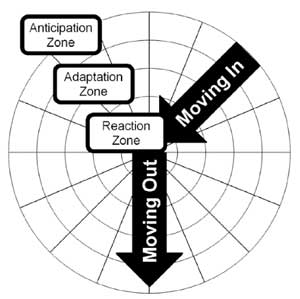02 Jan 2017 - {{hitsCtrl.values.hits}}

 In the past few weeks we identified the three major phases of renewal – rethink, reinvent and reposition. The first of these is concerned with identifying those parts of your company that are good candidates for renewal. This instalment describes rethink in more detail and provides tools to help you see the strategic gaps between you and your target customers.
In the past few weeks we identified the three major phases of renewal – rethink, reinvent and reposition. The first of these is concerned with identifying those parts of your company that are good candidates for renewal. This instalment describes rethink in more detail and provides tools to help you see the strategic gaps between you and your target customers.
Suppose you have a home entertainment audio system manufactured in early 1970s. Take a look at the system. The record player is a 125-year-old technology that has all but died except for a handful of audiophiles who love the vintage sound of scratchy vinyl. The radio is a 100-year-old technology that is in the mature phase of its lifecycle. The eight-track is a 1965 technology that lasted for about 12 years until it died of ridicule. The cassette deck is a 1970s technology that was superseded by CDs in the early 1980s, which, in turn, were hard hit by MP3 technology by the mid-1990s.
And if you are a member of the iPod generation you are probably on your fourth version of that technology by now. Now think of the names of the manufacturers of these audio systems. Did the oldest keep up with the changes?
Now, answer yourself – are you keeping up with the evolution of your industry? If not, you are slowly becoming irrelevant.
Mental radar screen 
Innovation is invigorating. Growth is exciting. But maintaining an ongoing business is exhausting. Thinking about renewing an ongoing business can be daunting and so we put it off until it’s too late. Yet, every company will face a life cycle dilemma—what to do before it starts to decline.
Interestingly, most managers view the life cycle as changeless. It can be stretched, they believe, but not broken. But once a business starts its decline, the good times have come to an end. But what if you look at maturity and even the start of the decline phase as an opportunity for renewal, growth and enhanced profitability?
To do that, you first need to sense the future. Activate your mental radar screen. In a way, your perception of the future is like a mental radar screen. You can see the blips that represent the incoming events, trends or products. You can also see blips that once were important to your business move out from the centre as they become less true or less relevant. If you track these effectively, you will have an edge on your competitors, who are focused only on the here and now.
Zones
On the radar screen shown in the figure below we have presented three concentric zones: Reaction Zone, Adaptation Zone and Anticipation Zone.
Think of the Reaction Zone as filled with blips representing things that are urgent. These define the agenda for most of your day with meetings, e-mails, text messages and other routine and time-consuming activities. Some of these are important, others are not, but you spend a lot of time reacting to them.
The Adaptation Zone contains blips that are farther out. They go on your to-do list hut they don’t require immediate action. For example, you might want to develop the English language skills among your sales staff. Given the ethnic and linguistic characteristics of your future workforce and customer base, doing so might be quite useful for your business. After all, how can you lead when you can’t communicate? But learning English can wait for few weeks.
Finally, the Anticipation Zone is filled with fuzzy blips and clues about the future that are so far away you can’t yet discern them clearly. Certainly they’re too far away for you to take immediate action. Some of the blips are static and will never move closer. Some are coming in at an angle and will miss your Reaction Zone. But some are early warnings of changes that will materially affect your business. How good are you at recognizing which may be important and which are not?
Decisions
Now let’s consider what you should look for in these zones as you determine what parts of your business are ripe for renewal.
Consider the three zones with respect to your assets and your customers’ wants and needs and ask this question: How fast is my industry evolving? Then compare that answer to how fast your organisation is evolving. If you are evolving more quickly than your industry, you may make mistakes but you will have time to correct them.
If you are evolving more slowly than your industry, you will continually be playing catch up but will never be able to do so. You will fall farther and farther behind your more nimble competitors.
How much of your time do you spend in the Adaptation Zone getting ready for the challenges that you know are coming, but are not impacting you right now? How much of your time do you spend in the Anticipation Zone thinking about what might be? If you are like most business leaders you spend the majority of your time in the Reaction Zone.
Watching your target market
If you really want to be a leader in your industry, it means that you must spend time anticipating a different marketplace. For example, Ford Car Company acted as if affordable fuel would last forever. Toyota saw something on the edge of their radar screen and started research and development (R&D) on hybrid engines in 1993.
What new target market needs and wants are on the edge of your radar screen?
Executives and consultants spent much of the 20th century working under the assumption that bigger was better. Businesses bowed before the altar of market share.
Product companies were caught in the frenzy of mass market and we built manufacturing capabilities that were very profitable when running at near-full capacity. But, when factory utilization dropped below 80 percent, the sales force was told to fill the factory. They could do so, but the margins dropped. The businesses became bigger but not always better, because we focused on the top line, not the bottom line.
Steps
As you think about rightsizing, start with the driving factors and try to balance your target market intentions with your operational execution.
Here are a few steps to lead you along the way.
Go back to the bigger boxes of society and the economy and look for the trends that are significant, how these trends will affect the marketplace and should you modify your understanding of the target market you need to move ahead.
For example, the music industry always made its money by selling physical products through a distribution system. If you wanted an LP or a tape or a CD, you went to your local music store and bought one. Then came the wave of (illegal) music downloads. No physical products. No stores, just friends sharing music. The music companies sued but to no avail. The digital cat was out of the bag and was never
going back.
Who won? Apple. They made the illegal legal and found an untapped target market – people who would pay 99 cents for a single song!
Now look at your business and ask yourself: Who do I need in order to succeed?” In the short term you clearly need your existing customers. However, you need to look out a bit longer and think about the future. For example, for the better part of a century, Sears –the American chain of department stores, was a dynamic retailer that knew its sweet spot – middle-class America. But starting in the 1990s, the middle class broke in two (the upper and the lower). So Sears became schizophrenic – sometimes it targeted bargain shoppers and sometimes it targeted more affluent shoppers. But its real mistake was not thinking and acting on the future. They should have realized that kids were not coming in their stores and figured out what to do about it.
(Lionel Wijesiri is a retired corporate director counting three decades of senior management experience. He is now an independent consultant and a freelance journalist. He may be contacted on [email protected])
10 Jan 2025 23 minute ago
10 Jan 2025 40 minute ago
10 Jan 2025 1 hours ago
10 Jan 2025 2 hours ago
10 Jan 2025 3 hours ago